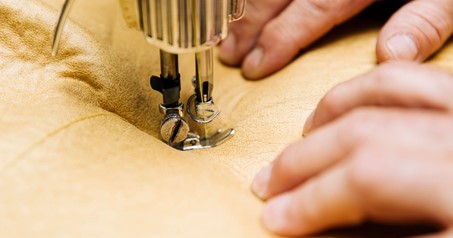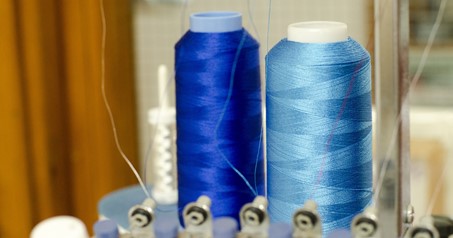Does mildew stains, flattened foam, or torn fabric keep your boat from looking its best?
Before you toss all your cushions, let’s look at what goes into getting your boat canvas and cushions back into tip-top shape so you can get the best look, the longest-lasting performance, and the best value.
Plus, we’ll cover some tips on hiring the best marine upholstery professional for your job.
First, what you need to know that makes marine upholstery different…

How is boat upholstery repair different than home or automotive?
While certainly most of the tools, skills, and even materials are the same for upholstery work for your home, car, or boat—marine upholstery has several specialized needs. If the person doing your upholstery work is not experienced with marine applications, it could lead to poor performing work and expensive early replacements.
What’s different?
To start—exposure to weather. Rain and sun are tough on upholstery. Even interior marine upholstery is subject to UV damage and premature fading. Exterior upholstery, even under biminis, gets the full brunt of the sun’s wrath, causing the fabric and the thread to break down. In addition, moisture from rain and humid conditions increases the risk of mold on the fabric and foam.
Further, salt increases the risk of corrosion to cushion zippers or rust stains from even the smallest metal notions like covered buttons or snaps.
An experienced professional with marine experience will make the best material choices for use in marine environments. They will better understand the durability of the fabrics, foams, and finishing hardware they select. For example, choosing non-corroding zippers, plastic or aluminum button inserts, and non-rusting staples.
Professionals only familiar with home upholstery and used to working with straight lines and square corners may struggle to achieve flawless fitting covers when working with complex angles and curving patterns.
A professional marine upholstery shop will also consider how the cushions and upholstered pieces need to be secured in place. For example, cushions need to stay in place when the boat heels, the wind picks up, or even walk on. By designing your upholstery with these considerations included in the patterning phase, you’ll get both a more professional look and better functioning upholstery for your boat.

When to restore, repair, or replace your boat’s upholstery
Sometimes the first step in bringing your boat’s upholstery up is figuring out if it just needs to be restored, repaired, or if it’s time to replace it entirely.
The last option comes with a hefty price point, no matter the size of your vessel. So finding an expert that you can trust to give you sound advice on your options is essential.
It is truly stunning what some of the vinyl and fabric restoration products can do to transform what appears to be marine upholstery that needs to be tossed out. Other times, mold or chemical stains just can’t be removed. Vinyl cleaners and conditioners can bring dramatic results, but your effort and time will be lost if the actual integrity of the fabric or thread has been compromised beyond a certain point.
Repairs can be a great way to improve the look of your boat’s upholstery and put off the expense of a full redo for a few seasons. Frequently fabric outlasts the thread used to stitch it together, and all it needs is to be resewn. Chafe points in bimini’s, chair arms, and equipment covers are common. However, a thoughtfully designed patch—either in the original fabric or a nice-looking piece of leather—can result in a more attractive item than the original. Even challenging to repair fabrics like vinyl can have repairs that restore their look and function.
Replacing becomes the best option when the money spent or trying to clean or patch the upholstery or fabric won’t improve the condition significantly or last long enough to justify the cost in time or money. Or replacing the upholstery may be the best option if it’s the style or color that is the big concern. Restitching isn’t going to get rid of the previous owner’s poorly selected floral print! Again, having a professional who can explain the pros and cons (and costs) in detail is super-helpful.
If it is time for you to treat your boat to new upholstery, it makes sense to spend some time understanding what upgrades are available. There are some crazy-impressive fabrics and materials on the market that change the way upholstery can be used on your boat.
- Sunbrella doesn’t just make canvas for shade and cockpit cushions. They have endless colors, textures, and even prints available.
- Crypton fabrics offer plush, luxurious feeling fabrics that won’t even blink at your red wine and suntan oils. Crypton also defends from mold and musty smells.
- PTFE thread (UV treated polyester thread) changes the game for outdoor sewn projects with its lifetime guarantee. Go from needing restitching every few years to a thread that will outlast your fabrics. However, with pricing that goes over $140.00 per 8 oz. spool, your average home sewer or automotive upholstery shop probably isn’t using it for every project. Therefore, you’ll need to specify your thread choice.
Can you do boat upholstery repairs yourself?
It depends. Cleaning and applying fabric restorer to your boat’s upholstery and vinyl fall easel into the DIY scope of projects.
While minor repairs and patches can be handled by boatowners with some sewing skills, most upholstery repairs require specialized equipment and knowledge. For example, home sewing machines will struggle with the thick fabrics or be able to make stitch lengths long enough to not compromise the fabric integrity. Further, most home sewing machines will not be able to even use a needle large enough for the proper sized thread job.
If you do want to tackle your boat upholstery repairs yourself, the company Sailrite has everything you’d need. Including specialized sewing machines, top marine-grade foams, professional-grade snap installation tools, and a vast selection of fabrics, threads, and notions. More importantly, they have tons of how-to videos to cover everything from replacing a zipper to sewing your own boat cockpit enclosure.
For those of us less talented—or with less free time—we’ll probably be seeking out a qualified professional.
Finding the perfect professional for your boat upholstery repair
So, where to find someone for your boat’s upholstery task?
As stated earlier, finding someone skilled specifically in the marine industry has many advantages. In addition, there is a degree of art to the profession. You’ll want someone who is meticulous with details and produces clean, straight stitches. The best upholstery shops produce work that rivals art.
Then there is the task of finding a professional who honors quotes—both for cost and time. You don’t want to miss weekend after weekend of being on the water because your canvas maker keeps delaying the project.
Word-of-mouth and personal recommendations are a great place to start your search. So is simply asking who did the work when you see a beautifully executed job on a neighboring boat.
If you are in the southeast Florida area, Onyx can quickly have some of the industry’s most respected professional marine upholsterers come out to your boat to discuss the best options for you. Onyx also has marine detailers to keep your boat and all its fabrics in pristine shape. Talk to someone today about your boat upholstery.
